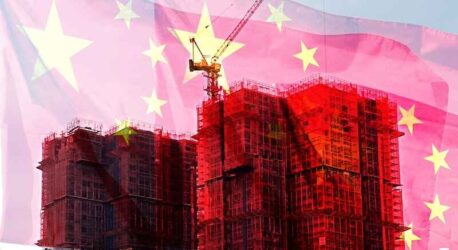The Problem With China’s Stimulus Deal
Shah Gilani|October 4, 2024

China has a problem.
It’s a problem so big… the government is throwing a Hail Mary.
And while it looks like the ball is on target… it’s inevitably going to be dropped in the end zone.
And that’s trouble for the U.S.
China is the second-largest economy on the planet. Whether it’s contracting or expanding matters.
For more than four decades, China’s economy expanded at an incredible rate. But that growth didn’t come because businesses made so much money that they could invest and expand… nor was there a surge of entrepreneurship that led to new business and more capital.
No… China’s growth came from government printing presses creating a mind-boggling layering of leveraged debt on top of leveraged debt on top of more leveraged debt.
And since the population didn’t have money for the kind of consumption that drives the U.S. economy, China’s economic imperative was to build and manufacture for export.
That’s how capital and the Chinese economy was engineered.
But those days are over.
Count the Ways
Let us count the ways China is in trouble…
- Exports have slowed… profits from those industries have shrunk, impacting workers, companies, and the country… and debt service requirements have increased.
- Domestic demand and consumption, which was supposed to take the place of export earnings, isn’t expanding. It’s contracting.
- Consumer spending has been declining, partly due to lingering pandemic-related uncertainties and a slowdown in income growth.
- A prolonged downturn in the real estate sector has led to defaults among major property developers, causing widespread financial distress and impacting related industries.
- High levels of corporate and local government debt pose risks to financial stability, limiting the ability to stimulate growth through more borrowing.
- External factors, such as slowdowns in major global economies and reduced demand for exports, are negatively impacting China’s trade performance.
- Ongoing supply chain issues, exacerbated by geopolitical tensions and pandemic-related disruptions, continue to affect production and exports.
- Increased regulation in many sectors, particularly technology and education, has created uncertainty for businesses and investors.
- An aging population and declining birth rates are leading to a shrinking workforce, which may hinder long-term economic growth.
- Heightened tensions with other countries, especially the U.S., are affecting trade relations and investor sentiment.
Is it any wonder the China set off several stimulus measures to boost the economy and stabilize the stock market?
These factors have created a challenging environment for economic growth in China. That’s why the latest round of “stimulus” is so necessary.
Artificial Wealth
Reserve requirements for banks have just been cut. Mortgage rates were cut to stimulate the moribund housing market. Local government lending institutions have been told to make lower interest loans available.
All in an effort to try and stimulate the economy.
And to create their own “wealth effect,” Chinese officials offered no-interest swaps to brokerages, funds, and insurance companies so they could get more capital to buy listed stocks.
On top of that… the government is offering $70 billion to listed companies to buyback shares.
But it’s all icing on a very overlayered debt cake and may not have a long-term impact on the true state of the economy.
Modern China’s never had a recession, let alone a depression. As debt service overwhelms profitability drivers, the inevitable bust may be around the corner.
A slowing Chinese economy has serious implications for the world.
- China is a major trading partner for the U.S. A slowdown may lead to reduced demand for U.S. exports, hurting American businesses that rely on sales to China.
- Many U.S. companies depend on Chinese manufacturing. Economic slowdowns can disrupt supply chains, leading to delays and increased costs for American firms.
- Investor sentiment may be affected by a slowing Chinese economy, leading to volatility in global financial markets.
- China is a major consumer of commodities. A slowdown can lead to decreased demand, resulting in lower prices for raw materials, which could impact U.S. producers.
- Reduced economic growth in China may lead to lower foreign direct investment in the U.S. from Chinese companies, affecting sectors like real estate and technology.
- A slowing Chinese economy can contribute to global economic stagnation, which may hinder U.S. growth prospects and lead to job losses in export-dependent industries.
Overall, a slowdown in China would have ripple effects in the U.S. economy.
But if China’s stimulus measures successfully boost economic growth, demand for U.S. exports could rise. American businesses would benefit, particularly in the agriculture, machinery, and technology sectors.
A recovering Chinese economy could lead to increased demand for commodities, which may drive up prices. This could benefit U.S. producers in sectors like energy and agriculture.
A stronger Chinese economy could increase competition for U.S. companies in global markets, particularly in sectors where China is focusing on innovation and technology.
Whether China’s stimulus measures work or not matters to the world and the U.S.
But I’m not optimistic China will be able to reconcile the trillions of dollars of deeply embedded debt on the books of Chinese households, businesses, banks, and government institutions.
And as far as Chinese stocks soaring thanks to short-term buying schemes, all I can say is enjoy the ride while it lasts.

Shah Gilani
Shah Gilani is the Chief Investment Strategist of Manward Press. Shah is a sought-after market commentator… a former hedge fund manager… and a veteran of the Chicago Board of Options Exchange. He ran the futures and options division at the largest retail bank in Britain… and called the implosion of U.S. financial markets (AND the mega bull run that followed). Now at the helm of Manward, Shah is focused tightly on one goal: To do his part to make subscribers wealthier, happier and more free.



